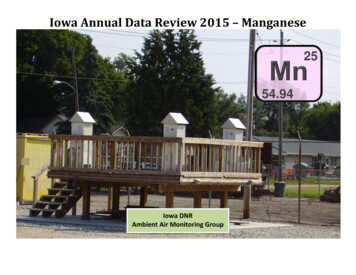2015 Business Management New Higher Finalised Marking .
NationalQualifications20152015 Business ManagementNew HigherFinalised Marking Instructions Scottish Qualifications Authority 2015The information in this publication may be reproduced to support SQA qualifications only on anon-commercial basis. If it is to be used for any other purposes written permission must beobtained from SQA’s NQ Assessment team.Where the publication includes materials from sources other than SQA (secondary copyright),this material should only be reproduced for the purposes of examination or assessment. If itneeds to be reproduced for any other purpose it is the centre’s responsibility to obtain thenecessary copyright clearance. SQA’s NQ Assessment team may be able to direct you to thesecondary sources.These Marking Instructions have been prepared by Examination Teams for use by SQA AppointedMarkers when marking External Course Assessments. This publication must not be reproducedfor commercial or trade purposes.
General Marking Principles for Higher Business ManagementThis information is provided to help you understand the general principles you must apply whenmarking candidate responses to questions in this paper. These principles must be read inconjunction with the specific Marking Instructions for each question. The marking schemes arewritten to assist in determining the ‘minimal acceptable answer’ rather than listing everypossible correct and incorrect answer.(a)Marks for each candidate response must always be assigned in line with these GeneralMarking Principles and the Specific Marking Instructions for the relevant question.(b)Marking should always be positive. This means that, for each candidate response, marksare accumulated for the demonstration of relevant skills, knowledge and understanding:they are not deducted from a maximum on the basis of errors or omissions.(c)If a specific candidate response does not seem to be covered by either the principles ordetailed Marking Instructions, and you are uncertain how to assess it, you must seekguidance from your Team Leader.(d)For each candidate response, the following provides an overview of the marking principles.Refer to the specific Marking Instructions for further guidance on how these principlesshould be applied. Marks will be awarded as follows for:(i)Questions that ask candidates to “Describe ”Candidates must make a number of relevant factual points, which may becharacteristics and/or features, as appropriate to the question asked. These pointsmay relate to a concept, process or situation.Candidates may provide a number of straightforward points or a smaller number ofdeveloped points, or a combination of these.Up to the total mark allocation for this question: 1 mark should be given for each relevant factual point. 1 mark should be given for any further development of a relevant point,including exemplification when appropriate.(ii) Questions that ask candidates to “Explain ”Candidates must make a number of accurate relevant points that relate cause andeffect and/or make the relationships clear. These points may relate to a concept,process or situation.Candidates may provide a number of straightforward points of explanation or asmaller number of developed points, or a combination of these.Up to the total mark allocation for this question: 1 mark should be given for each relevant point of explanation. 1 mark should be given for a further development of a relevant point, includingexemplification when appropriate.(iii) Questions that ask candidates to “Compare ”Candidates must demonstrate knowledge and understanding of the similaritiesand/or differences between things, methods or choices, for example. The relevantcomparison points could include theoretical concepts.Up to the total mark allocation for this question: 1 mark should be given for each accurate point of comparison.(iv) Questions that ask candidates to “Discuss ”Candidates must make a number of points that communicate issues, ideas, orinformation about a given topic or context that will make a case for and/or against.It is not always necessary to give both sides of the debate in responses.Up to the total mark allocation for this question: 1 mark should be given for each accurate point of knowledge that is clearlyrelevant.Page two
1 mark should be given for any further development of a relevant point,including exemplification or a conclusion when appropriate.Page three
Detailed Marking Instructions for each questionSECTION 1 – CASE STUDYQuestion1. (a)Expected Answer(s)(i) The type of production used to produce Google’sheadquarters is Job Production which is producing asingle product/one off product/products to exactrequirementsMax Mark1(ii) Advantages 5The headquarters can be designed to exactspecificationsA higher price can be chargedIt allows the customer to change the design/makealterations during the processMore motivated staffWill improve an organisation’s competitiveness if it isthe only one that can provide non-standard productsDisadvantages The wages paid will need to be higher to reflect staffskillso This will increase the overall final price of theproduct which may put some customers offThere can be higher than average R&D costsCosts are high as a variety of machinery/tools arerequired which may often be laying idleLead times can be lengthyPage fourAdditional GuidanceOnly accept a description of job production.Consequential marks can be credited for discussing theadvantages and disadvantages of other methods ofproduction described in (a)(i).Maximum 4 marks for advantages or disadvantages.
Question(b)Expected Answer(s) Allows organisation to spread risk over differentmarkets Can meet the needs of different market segments ‘Cash cows’ can fund other, riskier, ventures ‘Stars’ can allow a business to be a market leader ‘Problem Child’ products give businesses opportunityto invest ‘Dogs’ should be divested Increased profits can arise from selling differentproducts Newer products can replace those at the end of thelife cycle A range of products increases brand awareness Easier to launch new products with large existingportfolioMax Mark5Page fiveAdditional GuidanceAward 1 mark for each valid description given.Award 1 mark for each valid development point.Max 4 marks per advantage.
Question(c)Expected Answer(s)Max Mark4 Google uses flexible working patterns which meansstaff work when is best suited to them/when they are most productive Staff can work from home/where they want whichmight motivate them to be more productive Open plan/relaxed office layout encouragescollaboration which means better communication andidea sharingo This will also lead to better decisions beingmade Perks such as pool tables, bowling alleys, gyms etcwill mean staff are motivated and will work to abetter standardo This will also mean staff turnover will also below meaning quality trained staff aren’t lost tocompetitiono Perks will also attract the best staff to Googlemeaning they have an advantage over thecompetition Roof gardens, coffee shops etc will encourage staff tocommunicate with each other in a relaxed informalway, leading to better decision making Casual dress code will mean there is a relaxedenvironment in which to work in/will mean staff wantto come to the office Strong corporate identity through corporatecolours/language and jargon etc which will meanemployees feel part of the organisation Use of relaxed and informal language means staff feelcomfortable working there and perform wellPage sixAdditional GuidanceAward 1 mark for each valid explanation given.Award 1 mark for each valid development point.Accept explained benefits for the employee eg reductionin stress etc
Question(d)Expected Answer(s)(i) Revenue (sales): The amount of money received forselling goods or services during the year Max Mark2Gross Profit: The profit made from buying and sellingORGP is calculated by deducting cost of sales from salesrevenue(ii) Possible trends: Additional Guidance1Profit has increasedGross profit has increasedProfit for the year (Net Profit) has increasedPage sevenIf a candidate has calculated ratios then the profitabilityis seen as going down – this should be credited.
Question(e)Expected Answer(s)Horizontal integration Google could acquire (takeover) or merge with abusiness in the same sector of industry as itMax Mark4Additional GuidanceAward 1 mark for each valid description given.Award 1 mark for each valid development point.Vertical integration Google could acquire (takeover) or merge with abusiness in an earlier (backward) or Later (forward) sector of industry as itMaximum of 3 marks per method.Accept advantages and disadvantages as development.Conglomerate integration/diversification Google could acquire (takeover) or merge with abusiness in a completely different market as itDo not accept internal methods of growth.Outsourcing Google could contract out some of its procedures (egcatering, admin etc) To allow it to concentrate on core activitiesDivestment Google could sell off parts of its business to raisemoney to fund external growth eg takeoverManagement buy-in Merger Takeover Asset stripping Page eightWatch for repetition between merger/takeover andhorizontal integration.Watch for diversification and only award if clearlyexternal.
Question(f)Expected Answer(s)Advantages Max Mark5Fresh, new ideas/skills are brought into the businessWider pool of talent to choose fromThere is no ‘gap’ created by promoting from withinIt can avoid jealousy being created from one existingstaff member being promoted over anotherAdditional GuidanceAward 1 mark for each valid discussion point given.Award 1 mark for each valid development.No mark for a description of external recruitment.Disadvantages (g) Timely to recruit and select from such a vast poolInduction training will have to be carried outo Production time losto Can be costlyStaff may be de-motivated because there is nointernal promotionNew employee is unknown to the organisationGoogle has a charitable arm called Google.org whichpromotes renewable energyFunding environmental research proves Google iswilling to pay to help the environmentGoogle uses solar panels at the Googleplex to reduceits carbon footprintGoogle focuses on air quality/letting less harmfulchemicals into the environmentGoogle offers free EV charging stations for employeesvehicles to reduce emissionsGoogle treats its staff well ego Publicity in Fortune: Best Company To Work Foro Perks such as flexible working, gym equipmentetcPage nine3Award 1 mark for each valid description given.Award 1 mark for each valid development.Max 2 marks per way.Candidates must describe how each way demonstratesCSR.
SECTION 2Question2. (a)Expected Answer(s) Free samples to try Free entry to competitions Demonstrations of products - let customers see/trynew product before buying Credit facilities allow customers to buy and pay backover a period of time Free gift with purchase of the new product BOGOF – buy new product, get another item free Free delivery with purchase Offering discounts/promotional pricingMax Mark4Additional GuidanceAward 1 mark for each valid description.Award 1 mark for a development of a description.Max 3 marks per sales promotion.Candidate responses must be suitable for promotion of anew product.Accept into the pipeline promotions if suitable for a newproduct eg sale or return.Do not accept advertising.(b) Type of Product – suitable transportation/storage for type of product; product durability eg electrical,frozen food, flowers, liquid, livestockFinance available – if finance is limited this mayaffect the choice of channel selectedImage of Product – channel should reflect the qualityof the product eg high quality distributed throughexclusive, up-market retailersLegal restrictions – some products can only be sold incertain ways/places eg cigarettes/alcohol/medicinesWhere the product is in its life cycle – as itprogresses through growth to maturity it needs to bemore available to the marketDistribution capability of the organisation – does ithave transport or does this need to be outsourcedTechnical products – if highly technical it may needto be demonstrated through direct salesPage ten4Award 1 mark for each valid discussion point.Award 1 mark for a development of a discussion point.Max 3 marks per factor.Do not accept physical methods of distribution.Accept any other suitable response.
Question(c)Expected Answer(s)Max Mark2 Random sampling is when respondents are pickedrandomly whereas quota is picked from a group ofpeople with specific characteristics Random uses pre-selected respondents who must beinterviewed whereas Quota allows researcher to findrespondents who fit the characteristics required Random is expensive to carry out because specificrespondents must be interviewed and contacted untilthey are available whereas Quota is less expensiveas the interviewer simply needs to find suitablerespondents Random sampling reduces biased results because ofmethod of selection of respondents but bias canoccur with quota sampling as the interviewer decideswho to questionPage elevenAdditional GuidanceAward 1 mark for each valid comparison.Candidates must demonstrate knowledge andunderstanding of the differences and/or similaritiesbetween the methods of sampling.Accept any other suitable response.
Question3. (a)Expected Answer(s)Advantages Max Mark4Stock may be ordered in bulk and economies of scaletaken advantage ofReduced risk of pilferage as staff may be employed tomonitor issues of stockStock is maintained in appropriate conditions whichreduces wasteNo space is taken up in departments with storageSpecialist staff handle stock more efficientlyCentralised warehouse can be cheaper than usingmultiple warehousesCentralised ensures consistent stock handlingproceduresDisadvantages More time is taken to access stock – physically movingthe stock to department and the paperwork involvedAdditional s
‘Stars’ can allow a business to be a market leader ‘Problem Child’ products give businesses opportunity to invest ‘Dogs’ should be divested Increased profits can ari se f rom selling different products Newer products can replace thos e at the end of the life cycle A range of pro ducts increases brand awareness Easier to launch new products with larg e existing portfolio 5 Award 1 .
2015 2015 2015 2015 2015 2015 2015 2015 2015 2015 2015 2015 2015 2015 2015 2015 . Removal handle Sound output / wax protection system. 11 Virto V-10 Custom made shell Battery door Volume control (optional) Push button Removal handle . Before using
Alter Metal Recycling . 13 . 9/21/2015 156.73 9/24/2015 66.85 9/27/2015 22.24 9/30/2015 35.48 10/3/2015 31.36 10/6/2015 62.97 10/9/2015 36.17 10/12/2015 80.48 10/15/2015 84.99 10/18/2015 90.93 10/21/2015 82.
Phonak Bolero V70-P Phonak Bolero V70-SP Phonak Bolero V50-M Phonak Bolero V50-P Phonak Bolero V50-SP Phonak Bolero V30-M Phonak Bolero V30-P Phonak Bolero V30-SP CE mark applied 2015 2015 2015 2015 2015 2015 2015 2015 2015 2015 2015 2015 This user guide is valid for: 3 Your hearing aid details Model c
CONTENTS Introduction to Business 3 International Business 3 Corporate Governance 3 Business Law 4 Business Research Methods 4 Business Ethics 5 Business Economics/Accounting 5 Business Communication 5 Business Statistics/Decision Sciences 6 Business and Management Information Systems 7 Entrepreneurship and Small Business Management 8 Project Management 8 Operations Management/Supply Chain .
Adobe Photoshop Elements (Version 13 or higher) Adobe Illustrator (Version CS6 or higher) AlphaPlugins Launchbox Computerinsel Photoline 64 (Version 16 or higher) CorelDRAW (Version X6 or higher) Corel Painter (Version 12.1 or higher) Corel Paint Shop Pro (Version X6 or higher) Corel Photo-Paint (Version X6 or higher) Paint.NET (with the PSFilterPdn plugin) (Freeware: www.getpaint.net)
The Council on Higher Education (CHE) is an independent body established by the Higher Education Act, No. 101 of 1997. The CHE is the Quality Council for Higher Education. It advises the Minister of Higher Education and Training on all higher education issues and is responsible for quality assurance and promotion through the Higher Education .
2015-00732 ms. leima chanu shakti yambem 2015-00733 ms. fathima mufsina 2015-00735 mr. sanchit bhatia 2015-00743 ms. shiva manwatkar 2015-00746 mr. iytha sai mourya 2015-00748 ms. sohini das 2015-00755 ms. sahitya srinivasa rao 2015-00763 ms. rajasi chetan dharia 2015-00766 ms. manjushree ramakrishna 2015-00767 mr. abhishek narayan hl
Peekskill, NY 10566-8515 carlos.rodriguez@us.army.mil Jan. 2015 845 Feb. 2015 980 Mar. 2015 500 Apr. 2015 420 May. 2015 75 Jun. 2015 10 Jul. 2015 10 Aug. 2015 5 Sep. 2015 10 Oct. 2015 55 3,830 4 DMNA Armory Carlos Rodriquez Nov. 2014 200 10 West 195 Street Tel. #: 518-605-5183 Dec. 2014 534 Bronx, NY 10468-3072 carlos.rodriguez@us.army.mil Jan .






















